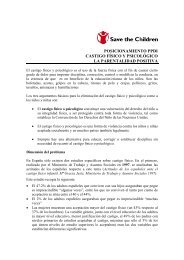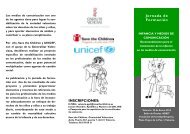Nutrition in the First 1,000 Days - Save the Children
Nutrition in the First 1,000 Days - Save the Children
Nutrition in the First 1,000 Days - Save the Children
Create successful ePaper yourself
Turn your PDF publications into a flip-book with our unique Google optimized e-Paper software.
16 <strong>the</strong> gloBal MalNUtritioN criSiS<br />
Four types of malnutrition<br />
Stunt<strong>in</strong>g – A child is too short for <strong>the</strong>ir age.<br />
This is caused by poor diet and frequent<br />
<strong>in</strong>fections. Stunt<strong>in</strong>g generally occurs before<br />
age 2, and <strong>the</strong> effects are largely irreversible.<br />
These <strong>in</strong>clude delayed motor development,<br />
impaired cognitive function and poor<br />
school performance. In total, 171 million<br />
children – 27 percent of all children globally<br />
– are stunted.15 stunted. 15<br />
Wast<strong>in</strong>g – A child’s weight is too low<br />
for <strong>the</strong>ir height. This is caused by acute<br />
malnutrition. Wast<strong>in</strong>g is a strong predic-<br />
tor of mortality among children under 5.<br />
It is usually caused by severe food short-<br />
age or disease. In total, over 60 million<br />
children – 10 percent of all children globally<br />
– are wasted.16 wasted. 16<br />
Underweight – A child’s weight is too low<br />
for <strong>the</strong>ir age. A child can be underweight<br />
because she is stunted, wasted or both.<br />
Weight is a sensitive <strong>in</strong>dicator of short-term<br />
(i.e., acute) undernutrition. Whereas a<br />
deficit <strong>in</strong> height (stunt<strong>in</strong>g) is difficult to<br />
correct, a deficit <strong>in</strong> weight (underweight)<br />
can be recouped if nutrition and health<br />
improve later <strong>in</strong> childhood. Worldwide,<br />
more than 100 million children are underweight.<br />
weight.17 17 Be<strong>in</strong>g underweight is associated<br />
with 19 percent of child deaths. deaths.18 18<br />
Micronutrient deficiency – A child<br />
lacks essential vitam<strong>in</strong>s or m<strong>in</strong>erals.<br />
These <strong>in</strong>clude vitam<strong>in</strong> A, iron and z<strong>in</strong>c.<br />
Micronutrient deficiencies are caused by<br />
a long-term lack of nutritious food or by<br />
<strong>in</strong>fections such as worms. Micronutrient<br />
deficiencies are associated with 10 percent<br />
of all children’s deaths, or about one-third<br />
of all child deaths due to malnutrition.<br />
malnutrition.19 19<br />
maLnUtRition and ChiLd moRtaLity<br />
Every year, 7.6 million children die before <strong>the</strong>y reach <strong>the</strong> age of 5, most<br />
from preventable or treatable illnesses and almost all <strong>in</strong> develop<strong>in</strong>g countries.20<br />
Malnutrition is an underly<strong>in</strong>g cause of more than a third (35 percent) of <strong>the</strong>se<br />
deaths.21<br />
A malnourished child is up to 10 times as likely to die from an easily preventable<br />
or treatable disease as a well-nourished child.22 And a chronically<br />
malnourished child is more vulnerable to acute malnutrition dur<strong>in</strong>g food shortages,<br />
economic crises and o<strong>the</strong>r emergencies.23<br />
Unfortunately, many countries have not made address<strong>in</strong>g malnutrition and<br />
child survival a high-level priority. For <strong>in</strong>stance, a recent analysis by <strong>the</strong> World<br />
Health Organization found that only 67 percent of 121 mostly low- and middle-<strong>in</strong>come<br />
countries had policies to promote breastfeed<strong>in</strong>g. Complementary<br />
feed<strong>in</strong>g and iron and folic acid supplements were <strong>in</strong>cluded <strong>in</strong> little over half of<br />
all national policy documents (55 and 51 percent, respectively). And vitam<strong>in</strong> A<br />
and z<strong>in</strong>c supplementation for children (for <strong>the</strong> treatment of diarrhea) were part<br />
of national policies <strong>in</strong> only 37 percent and 22 percent of countries respectively.24<br />
While nutrition is gett<strong>in</strong>g more high-level commitment than ever before, <strong>the</strong>re<br />
is still a lot of progress to be made.<br />
Persistent and worsen<strong>in</strong>g malnutrition <strong>in</strong> develop<strong>in</strong>g countries is perhaps<br />
<strong>the</strong> s<strong>in</strong>gle biggest obstacle to achiev<strong>in</strong>g many of <strong>the</strong> Millennium Development<br />
Goals (MDGs). These goals – agreed to by all United Nations member states <strong>in</strong><br />
2<strong>000</strong> – set specific targets for end<strong>in</strong>g poverty and improv<strong>in</strong>g human rights and<br />
security. MDG 1 <strong>in</strong>cludes halv<strong>in</strong>g <strong>the</strong> proportion of people liv<strong>in</strong>g <strong>in</strong> hunger.<br />
MDG 2 is to ensure all children complete primary school. MDG 4 aims to<br />
reduce <strong>the</strong> world’s 1990 under-5 mortality rate by two thirds. MDG 5 aims to<br />
reduce <strong>the</strong> 1990 maternal mortality ratio by three quarters. And MDG 6 is to<br />
halt and beg<strong>in</strong> to reverse <strong>the</strong> spread of HIV/AIDS and <strong>the</strong> <strong>in</strong>cidence of malaria<br />
and o<strong>the</strong>r major diseases. Improv<strong>in</strong>g nutrition helps fuel progress toward all<br />
of <strong>the</strong>se MDGs.<br />
With just a few years left until <strong>the</strong> 2015 deadl<strong>in</strong>e, less than a third (22)<br />
of 75 priority countries are on track to achieve <strong>the</strong> poverty and hunger goal<br />
(MDG 1).25 Only half of develop<strong>in</strong>g countries are on target to achieve universal<br />
primary education (MDG 2).26 Just 23 of <strong>the</strong> 75 countries are on track to<br />
achieve <strong>the</strong> child survival goal (MDG 4).27 And just 13 of <strong>the</strong> 75 countries are<br />
on target to achieve <strong>the</strong> maternal mortality goal (MDG 5).28 While new HIV<br />
<strong>in</strong>fections are decl<strong>in</strong><strong>in</strong>g <strong>in</strong> some regions, trends are worrisome <strong>in</strong> o<strong>the</strong>rs.29 Also,<br />
treatment for HIV and AIDS has expanded quickly, but not fast enough to<br />
meet <strong>the</strong> 2010 target for universal access (MDG 6).30<br />
mateRnaL maLnUtRition<br />
Many children are born undernourished because <strong>the</strong>ir mo<strong>the</strong>rs are undernourished.<br />
As much as half of all child stunt<strong>in</strong>g occurs <strong>in</strong> utero,31 underscor<strong>in</strong>g<br />
<strong>the</strong> critical importance of better nutrition for women and girls.<br />
In most develop<strong>in</strong>g countries, <strong>the</strong> nutritional status of women and girls is<br />
compromised by <strong>the</strong> cumulative and synergistic effects of many risk factors.<br />
These <strong>in</strong>clude: limited access to food, lack of power at <strong>the</strong> household level, traditions<br />
and customs that limit women’s consumption of certa<strong>in</strong> nutrient-rich<br />
foods, <strong>the</strong> energy demands of heavy physical labor, <strong>the</strong> nutritional demands<br />
of frequent pregnancies and breastfeed<strong>in</strong>g, and <strong>the</strong> toll of frequent <strong>in</strong>fections<br />
with limited access to health care.<br />
Anemia is <strong>the</strong> most widespread nutritional problem affect<strong>in</strong>g girls and women<br />
<strong>in</strong> develop<strong>in</strong>g countries. It is a significant cause of maternal mortality and<br />
can cause premature birth and low birthweight. In <strong>the</strong> develop<strong>in</strong>g world, 40

















